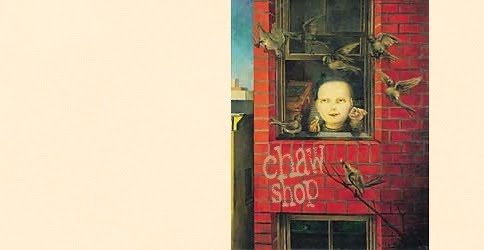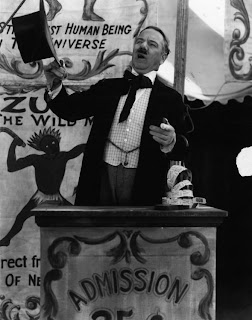At the end of last month, I took the subway up to Columbia University for a talk on book reviewing by Laura Miller of Salon.com. I'm fairly familiar with Miller's work: I sometimes read her column, and I eagerly raced out to buy her collection of essays on the Chronicles of Narnia, THE MAGICIAN'S BOOK, when it first came out in 2008. Though it was a lot less provocative than I hoped and expected – in my estimation, Lev Grossman's novel
THE MAGICIANS does a better job of critiquing the authoritarian underpinnings of Lewis's original text and celebrating the imaginative possibilities it offers – I did at least appreciate her interest in digging into her subject at a far greater length than most non-academic readers would consider palatable. Even if the book too often veered into a weird combination of straightforward literary biography (we get accounts of Lewis's religious conversion, love life, and relationship with his brother) and overgeneralizations based on vague personal anecdotes ("Adults remember learning the truth about Santa Claus as a miniature tragedy. Some of us cried."), Miller seemed like the kind of writer who cared more about the ideas she was expressing than about the size of her readership.
That was before I heard her talk. Miller opened her lecture with a lengthy discourse on Google Analytics, a tool that, in its mathematically precise tabulation of “hits” has come to serve as the only muse Miller dares consult in her selection of new titles to review. Miller explained that with her audience, reviews of nonfiction always garner more online attention than reviews of literary novels or, god forbid, story collections; that reviews of books by white authors usually trump reviews of books by writers of color; and that reviews of debut fiction get the fewest hits of all. Expressing repeated concern over the possibility of losing her job – an excuse that sounds more like “Just following orders” to me every day, but maybe that’s the
unemployment talking – she explained that, though she could occasionally “get away with” (more on this telling phrase in a bit) reviewing books by worthy minorities or serious novelists, she’s ultimately beholden to her readership. Her loyalty, she told us, is not to the books she discusses, but solely to those nameless clickers scrolling away at home.
While Miller was saying all this, I sketched a portrait of her with horns and dripping fangs holding a pitchfork, and wrote, “This lady is the devil” below in Gothic script for good measure. But after even a moment’s reflection, I had to admit my feelings were far more complex. For one thing, it’s tough to fault someone for being honest, especially when she’s speaking to a roomful of intellectuals and being honest means admitting she routinely throws her fellow intellectuals under the bus. (This is not something
James Frey would do, for example.) For another thing, Miller wasn’t passing the buck – “My editor told me to review this book, not that one,” etc. She wasn’t just claiming that a change in her reviewing habits would result in her dismissal from Salon.com (of which she is a co-founder); she was arguing that it
should. At one point, she mentioned that some readers have gotten burned from reading too many appreciative reviews of novels that will in fact bore or disappoint them. These readers, Miller feels, have been betrayed by the very folks whose job it is to tell them about books they’ll like. They’ve been let down, and she’s not going to do the same thing to her audience. Like P.T. Barnum, she believes in giving the people what they want.
Laura Miller: the carnival barker of the literary world.
This, the founding principle of Miller’s philosophy of book reviewing, went unremarked in the lecture I attended, but I suspect I wasn’t the only one there who felt there was something potentially controversial in it. Critics, after all, haven’t always played the role of Consumer Reports, directing book buyers to the products best suited to their existing wants and tastes (“Readers who liked THE LOVELY BONES also enjoyed SKELETON PROM”). We don’t regard books by great 20th century authors like Woolf, or Faulkner, or Pynchon as significant because the average straphanger – then or now – can rip through them like tween vampire romances. We regard them as significant because someone in the intellectual community at the time recognized what the authors were up to, and championed it.
Now don’t get me wrong: I totally get why Miller would regard nepotism, or even charitably exaggerated praise, in reviewing as dishonest, because I do too. But priding oneself on consistently delivering the goods to a community that isn’t much interested in, among other things, African-Americans or the English language also seems to be missing the point. Maybe I’m idealizing the past, but wasn’t there a time when a critic’s responsibility was to articulate and advance a certain aesthetic – when she was compelled not merely to predict what her readers would like to read, but to prescribe for them a new way of reading? When, to put it plainly, the critic’s responsibility was to art?
It seems to me that there was such a time (and that maybe it’s
not quite over yet). Yet even in the second two thirds of Miller’s talk, where she addressed the question “What do critics look for in debut novels?”, art didn’t come up much. Miller instead spent much of her time rattling off a laundry list of what she acknowledged were idiosyncratic personal preferences – she doesn’t much care for novels about stage magicians or ranch hands, for instance – with the inevitable caveat, “But if you do it well, you can get away with anything.”
There those words were again – “get away with.” This compound verb troubled me at the time, and troubled me again even more deeply when I read
the essay Miller wrote about the same Columbia lecture for Salon.com, where she uses the phrase twice in quick succession. The words “get away with” imply a set of rules, a duty that one is cleverly escaping via loophole. Yet what obligation does a writer have to cater to Miller’s unguessably individual predilections, or even the more widespread, but equally arbitrary penchants of the majority of readers?
The unnamed obligation, I’d say, is economic. What Laura Miller is actually espousing is only a slightly more sophisticated variant on the shopworn capitalist slogan, “The Customer is Always Right.” In “Advice to Writers: Skip the Scenery,” for example, Miller starts out making what seems like a justified criticism about the way passages of scenic description pointlessly slow the action in Tea Obreht’s THE TIGER'S WIFE. One expects Miller to go into a discussion, a la Gardner, of the fictive dream, or of the needless intrusion of cinematic conceits in contemporary fiction (the excerpted sketch of the village reads to me like an establishing shot in a so-so screenplay). But instead, Miller's next move is puzzling. She doesn’t argue that the quoted passage, or others like it, makes THE TIGER'S WIFE less worth reading – she simply claims that the problem with the passages is that they will make the book less read: “[T]he risk is great that readers will conclude [that] the novel has no particular place to go and will soon wander off themselves.” And she condemns all similar passages, sight unseen, for the same reason: “When it comes to more than two or three sentences of description at a go, a novelist is always somewhat on sufferance with contemporary readers” (though of course “a writer of genius can
get away with just about anything” – emphasis mine).
Arguing that there’s difference between “less worth reading” and “less read” may sound like pure semantics, but it really isn’t. To say a book is “less worth reading” is to pose an argument about aesthetic value, one that ultimately demands an underlying theory or point of view about how fiction can and should work. But to say a book is “less read” or will be “less read” is to make a statement about market viability – about the number of “hits,” actual or probable. Remember Google Analytics? Perhaps the reason Laura Miller so admires it is that it automatically knows what people actually read – a task to which she, not being a computer, has chosen to devote much of her time and critical thought.
And thus that troublesome “getting away with” makes a lot more sense. When Miller refers to a book “getting away with” something, she means that the writer took a risk with, but ultimately didn't sacrifice, market viability. According to Miller (again in
the Salon.com essay), Elizabeth Kostova and David Wroblewski both succeed despite their long descriptions, though Miller finds Kostova’s descriptions evocative and Wrolewski’s pointlessly florid. In Miller’s critical framework, there’s no possibility that Kostova’s work succeeds because of the very element that makes it less appealing to a broad audience. To Miller, market viability and success are synonymous. Just as she considers herself responsible to the web surfers behind her column’s page view spikes, so too (she would say) are literary authors responsible to their pool of likely readers. Anything that makes the book tougher going for these folks risks the whole enterprise, regardless of what it accomplishes aesthetically.
“The most ravishing descriptions in the world are wasted if they aren't read in the first place,” Miller writes. I suppose I’ll concede this point: if a book filled with “ravishing descriptions” is written, then instantly incinerated before a single human being can read it, and the memory of the words within is magnetically erased from the mind of the author and then, for good measure, a superhuman turns back the wheel of time till before those cursed words were ever inscribed upon paper, then yes, that would be a waste. But this isn’t what Miller is actually talking about. In reality, even books that are published by eensy presses and go out of print in a matter of months have some readers, sometimes very devoted ones. (Believe it or not, even poets get the occasional fan letter. And somebody’s buying
these shirts.) Miller is saying that a book that reaches a tiny but loyal following is a waste compared to a book that reaches a much larger audience, regardless of what the books in question are up to, and regardless of how intense an impression each work makes on those who bother. And it’s there that I have to disagree with her. If I spend years of my life writing a novel and I reach only a couple of people, but I really reach them – touch them, amaze them – in the way my favorite books have reached me, then I’m going to consider the time well spent.
And if one of those people happens to be a book critic, well, so much the better.















